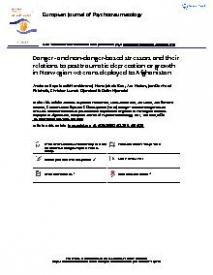Danger- and non-danger-based stressors and their relations to posttraumatic deprecation or growth in Norwegian veterans deployed to Afghanistan
Objective: This study aimed to explore how exposure to danger-based and non-dangerbased stressors may influence personal changes in veterans (N = 4053) after deployment to Afghanistan.
Method: Twelve war zone related traumatic events were used to form two stressor categories. The non-danger-based category included two stressor types: Moral Challenges and Witnessing, and the danger-based category included one type: Personal Threat. Thus, three stressor types were explored in relation to self-reported personal changes after war zone stressor exposure, e.g. negative changes labelled posttraumatic deprecation, positive changes labelled posttraumatic growth or no major change. Furthermore, the relationship between the stressor types and reported levels of distress were explored.
Results: The two non-danger-based stressor types, Moral Challenges (p < .001) and Witnessing (p < .001), were both significantly more associated with deprecation rather than growth, when compared to Personal Threat. Moreover, the non-danger-based stressors were significantly associated with a rise in posttraumatic stress symptoms, as well as a rise in symptoms of depression, anxiety and insomnia (p < .001). In contrast, exposure to the danger-based stressor was only significantly associated with a rise in the posttraumatic stress symptoms in the current model (p < .001). Reports of no-change were significantly associated with low degrees of exposure to all the three stressor types (p < .001).
Conclusion: The current study highlights the special adverse effects of non-danger-based stressors. Our findings show that they are more associated with posttraumatic deprecation rather than with growth. This underscores the heterogeneity of responses to traumatic events and adds to the current knowledge about the impact of various stressor types.
HIGHLIGHTS
• Danger-based trauma is closely linked to posttraumatic growth.
• Non-danger-based trauma is mostly linked to posttraumatic deprecation.
• Non-danger-based trauma is associated with a broader range of distress symptoms after exposure.
Geachte bezoeker,
De informatie die u nu opvraagt, kan door psychotraumanet niet aan u worden getoond. Dit kan verschillende redenen hebben,
waarvan (bescherming van het) auteursrecht de meeste voorkomende is. Wanneer het mogelijk is om u door te verwijzen naar de bron
van deze informatie, dan ziet u hier onder een link naar die plek.
Als er geen link staat, kunt u contact opnemen met de bibliotheek,
die u verder op weg kan helpen.
Met vriendelijke groet,
Het psychotraumanet-team.
In: European Journal of Psychotraumatology, ISSN 2000-8066 | 10 | 1 | 1601989
https://doi.org/10.1080/20008198.2019.1601989


